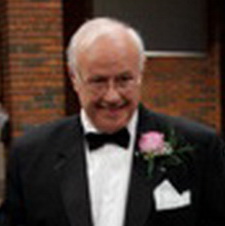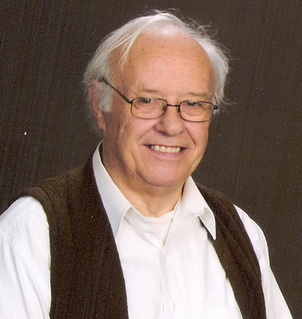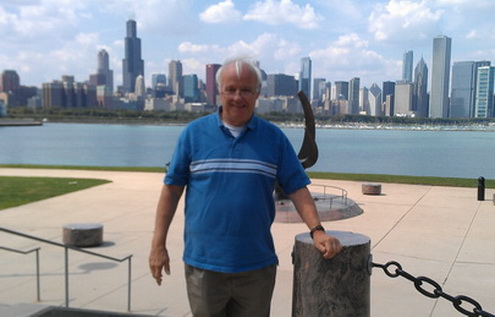| |
Bruce L. Cook, Ph.D.

Global Peace Science Hero: http://peacefromharmony.org/?cat=en_c&key=697
GHA Vice-President
GHA Ambassador of Peace and Disarmament from Harmony Publisher and Editor President, World Writers Resources, Inc.; Author, Harmony of Nations: 1943 – 2020, Just Fiction Editions, 2012
Coauthor: Global Peace Science, 2016 (http://peacefromharmony.org/?cat=en_c&key=585)
7337 Grandview Ct. Carpentersville, IL 60110, USA 312-859-8090 www.harmonyofnations.com author-me.com www.peacefromharmony.org/?cat=en_c&key=544
http://www.wwpo.org/
Publication of the GHA updated book, "Global Peace Science", 2016 in the USA: www.reservebook.com
-----------------------------------------------------------------------------------------------------------------
Strategies for Peace and SPHERONS before Nuclear Aggression Review of the book “Strategies for Peace” By Bruce L. Cook and Maria Cristina Azcona (eds), 254 Pages, 2016, 16 articles by 15 coauthors from 10 countries (5 coauthors are from the USA): http://www.lulu.com/spotlight/cookcomm Review by Dr. Leo Semashko Publication: In Russian: http://peacefromharmony.org/?cat=ru_c&key=617 In English: http://peacefromharmony.org/?cat=en_c&key=544 This book (hereinafter: Strategies) was published in July 2016, six months after the publication of Global Peace Science (GPS) by 174 co-authors from 34 countries in January 2016. GPS includes 309 articles on 616 pages (http://peacefromharmony.org/docs/global-peace-science-2016.pdf). Between these two books there is a direct link in content, form and coauthors: the 8 from Strategies are coauthors of GPS. It determines its first and most important advantage: Strategies repeat the attempt and experience of the collective awareness of one of the most important problems of global peace. Another advantage of Strategies is consideration of a number of positive strategies that are useful for the peacebuilding process: leadership, bilingualism, interspirituality, world citizenship, family, women, education, medicine, art and conflict resolution. Of course, this is only a small part of similar strategies, the number of which is calculated by tens. All of them are integrated into GPS as its organic parts (GPS, Chapter 8, see 25 strategies). In the critical part of our review, we should note that this work has not freed itself from a main disadvantage of traditional peacemaking. It, as the others similar it, does not make the key issue of peacemaking about elimination of all wars, before which it is powerless throughout history. Especially revealing is the last century with its two world wars (100 and 75 years ago), and thousands of local conflicts, a bad trend of which increases in the new age by the impending threat of nuclear war. Traditional peacemaking is powerless to oppose this dangerous trend any effective strategy capable to overcome the growing militaristic threats. The cause of inborn weakness of traditional peacemaking is its internal ideological fragmentation, its subjectivism and psychologism lacking a uniting objective fundamental basis, generally expressed as common acceptable science. In short, this reason is the lack of science of global peace, which cannot be replaced by the partial, subjective and broken peace studies and researches, which are similar to countless attempts of the blinds to know an elephant. The most critical thinkers oppose to insuperable fragmentation of traditional peacemaking a task "the search for common paradigms of peace thinking beyond the paranoias of competing world-views" (IPRA, Peace Theories Commission: http://ipra2016.org/index.php/9-uncategorised/114-peace-theories-commission) and without "deaf choir", in which everyone sings its tune ignoring the others and persisting in its originality. The Strategies authors could be to avoid the blemish of fragmentation "paranoia" if they would take the GPS holistic power. But paradoxically that even its co-authors, highly appreciating its, such as Bruce Cook and Maria Azcona, did not even mention it in their book, even in the bibliography as though it does not exist in reality. Their remarkable qualifications of GPS worthy of multiple repetitions are below: Bruce Cook: “SPHERONS can do to achieve a fairly stable world peace, although this theory gives rise many questions because of its novelty and originality. All peace workers need to work together in harmony with this scientific theory... that can save the world before it's too late… [GPS] is a unique and prodigious accomplishment… [that] introduces a new concept in peace efforts based on global demographics of harmonious classes, with SPHERONS making the deep social structure. It offers an alternative to more than two centuries where global conflicts were solved by military science, which still does not have an alternative. It further presents more than 300 articles from 174 peace workers who are distinguished leaders in the global harmony movement in 13 chapters. They cover a startling variety of considerations including social, philosophical, historical, structural, functional, political, economic, personal, educational, psychological, legal and other areas. GPS is first in history to offer a science of world peace, after more than two centuries of the birth of military science in the Adam Bülow’s book in 1799. The GPS cognitive result is the first scientific extremely laconic formula of peace: “peace comes from harmony of SPHERONS through science”, which determines a source, social actors and main way of global peace. The objective grounds and numerous details of this formula are disclosed in the book’s 13 chapters in different dimensions:… The 622-page volume is available on www.reservebook.com” (http://peacefromharmony.org/?cat=en_c&key=544). Maria Azcona: “Writers of this unprecedented “Global Peace Science” (GPS) book are trying to create for global community a powerful and more effective scientific paradigm capable be an alternative to military science and all wars on Earth. … [This paradigm] embraces diversity of all main cultures in GPS. The similar love to all in the world is a love to literature, to knowledge as equal for all humanity passion. A unique scientific flower of this literature is GPS, in which the Chapter 11 is dedicated to Peace Poetry and Art. The results are born in this nest of harmony where the child is Global Peace as Peace from Harmony via Science in a common denominator. Literature is Beauty through harmony in words/knowledge and Peace Literature is an ode to Beauty because incarnates it in a new reality…. Is it possible to live in peace? Surely yes, since we are able to see civilized societies grow peacefully leaving the other to live peacefully too as this unfolded in the unique GPS in its wide scientific picture of global peace….So don't let to afterwards reading the GPS book. The book needs to be studied at all universities worldwide to be a basis of new humankind able to build a conscious peaceful life by the universal peacemaking actors - SPHERONS - disclosed in GPS. This paradigm is harmonic revolution of peacebuilding thinking and consciousness for new humanity”(http://peacefromharmony.org/?cat=en_c&key=36). As we can see, both give excellent characteristics of GPS as a new way and effective peace-building strategy! But they do not go on this way in their Strategies. Why? This question is open for this book, which can be finding an honest answer in its new reissue in the following year. The authors of this book cannot understand and recognize that every peace strategy is a useful peacebuilding brick but scattered and unrelated by scientific unity and general architectural plan of global peace, they form only a pile of bricks useless for it and helpless to resist any war. Therefore, the Strategies book is a mirror of fragmentation into peacemaking and its impotence before the war. The critique of traditional peacemaking more detail see in GPS Chapter 4.6: "One Hundred Years of Defeats and Degradation" (http://peacefromharmony.org/?cat=en_c&key=595). Comparison of the two peacemaking books is not in favor of Strategies. Its strategies could be the worthy parts and development of GPS if they would unite around its fundamental scientific idea of SPHERONS - harmonious classes of the population, who make a deep social structure of humanity and are constant actors of global peace, which first disclosed in this science. Strategies offer the positive but ineffective strategies for peace beyond scientific unity. GPS offers SPHERONS as an effective strategy and scientific, integral architecture of global peace for all its private strategies. Unfortunately, the Strategies authors, on the unknown reasons, ignored this great peacemaking opportunity that demonstrates once again the crisis and degeneration of traditional peacemaking with all its numerous but useless private achievements. But this possibility is preserved for them in the future after a deeper acquaintance with the GPS foundations, primarily with the scientific theory of SPHERONS most briefly (20 pages) generalized here: http://peacefromharmony.org/?cat=en_c&key=423. SPHERONS - this is a common paradigm of peacebuilding thinking and one holistic scientific fundamental peacemaking strategy, which includes all other its private strategies. It ensures that it is not able to provide the traditional peacemaking: the achievement of global peace and the victory of peace over war. We hope that our review will encourage the authors Strategies in direction of this holistic and effective strategy for world peace that is critical in our time. Today, the US/NATO deploy the nuclear weapons at the western borders of Russia and establish for itself by unilateral barbarous right of "first nuclear strike" launched the US still in Hiroshima-1945. They created a situation of "Barbarossa" aggressive Nazi Plan 1941, which was the center of WWII. Peacemakers of 2016 are powerless against the threat of nuclear aggression as well as peacemakers of 1941 were powerless against Hitler's aggression. What is a strategy from the ten listed in Strategies, which is able to withstand nuclear aggression fatal for humanity? The answer is clear - none of them are capable on it like 75 years ago. Unfortunately, this question as the most actual for modern peacemaking, even not arises on the Strategies pages that characterizes the abstraction of modern peacekeepers from the real problems of global peace protection and neglect of these problems. How the world nations, put before the deadly threat of nuclear annihilation, can appreciate such peacemaking? The question is rhetorical. None evaluation, except for the extremely negative, cannot be. This is a fair and only true evaluation, requiring a radical, revolutionary change in peacemaking, which promises only GPS integrating all peacebuilding constructive ideas and giving them practical force by their scientific association. In more details this situation is considered in GPS. Today the world remains in peacemaking as defenseless before the war, especially nuclear, as well as 100 and 75 years ago. only GPS, as a scientific and radically new peacemaking, gives humanity fundamentally solid hope for its protection and salvation from nuclear war. Could the Strategies authors admit it? Or offer an alternative scientific paradigm and get out from the figure of silence? This is necessary in order to jointly develop GPS further as the most effective strategy for global peace before impending nuclear aggression. Leo Semashko, Ph.D. (Philosophy), Founding President, Global Harmony Association (GHA) since 2005; GHA Honorary President since 2016; State Councilor of St. Petersburg; Philosopher, Sociologist and Peacemaker from Harmony; Author of more than 400 scientific publications, including 18 books in 1-12 languages; Author of Tetrism as the unity of Tetraphilosophy and Tetrasociology – science of social harmony, global peace and harmonious civilization; Director: Tetrasociology Public Institute, Russia; Director, GHA Website “Peace from Harmony”: http://peacefromharmony.org; Initiator, Manager and Editor in Chief of the book project “Global Peace Science” (GPS). Address: St-Petersburg, Russia; Phone: +7(812)-597-6571 E-mail: leo.semashko [at] gmail.com Personal page: http://peacefromharmony.org/?cat=en_c&key=253 22/08/16 ------------------------------------------------------------------------------------------------------
Bruce L. Cook* Statement about Global Peace Science, 2016 I have great respect for the long history of GHA as a prime mover for peace and for its current direction under renewed leadership based in India. Among the nations which can offer wisdom for peace, India and the person of Dr. Subhash Chandra are perfectly suited to provide this leadership. For my part, I have been pleased to help GHA produce and offer for sale their two major books, ABC and GPS (Global Peace Science),in my booklist at www.reservebook.com. As a publisher and editor, I will do my best to continue helping GHA and its members and other peace workers to make their information available to the world. Please see my review of GHA’s new volume, Global Peace Science, below. As workers for peace, we are individuals working for a common purpose. As such, we remain open to all peace efforts and we work together with mutual respect. . We offer our talents in an effort to do whatever it takes to bring world peace. None of us claims perfection. I personally feel that the immediate problem hindering world peace today is a cascading quest for power by many leaders. Sadly, even in my own native country of the USA, I am embarrassed to see at least one potential leader whose quest for personal power seems to override any sense of fairness, justice or harmony. Further, all of us are certainly aware of rogue leaders who seek personal power on the pretense that they are acting for a religious cause or another false representation. In my mind, considering today's grotesque threats to world peace, it is imperative to discuss new strategies to stop the rogue leaders before they have made everyone so afraid of their threats that world peace would be out of the question. I believe we need to realize that global communication has created a new world environment in which bizarre quests for personal power are no longer tolerated by world citizens. How can this be achieved? GHA’s new volume introduces new language that enables us to say what Spherons can do to achieve a fairly stable world peace, although this theory gives rise many questions because of its novelty and originality. All peace workers need to work together in harmony with this scientific theory. May our Global Harmony Association be a shining example of the harmony that can save the world before it's too late. I will be privileged to offer my technical and editorial skills on the GHA Board. Now here is my review of Global Peace Science or Peaceloveology, Peacescience by Dr. Leo Semashko and 173 coauthors from 34 countries, (Elgin, IL: Cook Communication, 2016). This book is a unique andprodigious accomplishment as the second major text from Global Harmony Association introduces a new concept in peace efforts based on global demographics of harmonious classes, with SPHERONS making the deep social structure. It offers an alternative to more than two centuries where global conflicts were solved by military science, which still does not have an alternative. It further presents more than 300articles from 174 peace workers who are distinguished leaders in the global harmony movement in 13 chapters. They cover a startling variety of considerations including social, philosophical, historical, structural, functional, political, economic, personal, educational, psychological, legal and other areas. Global Peace Science (GPS) is first in history to offer a science of world peace, after more than two centuries of the birth of military science in the Adam Bülow’s book in 1799. The GPS cognitive result is the first scientific extremely laconic formula of peace: “peace comes from harmony of SPHERONS through science”, which determines a source, social actors and main way of global peace. The objective grounds and numerous details of this formula are disclosed in the book’s 13 chapters in different dimensions: social, philosophical, historical, structural, functional, political, economic, personal, educational, psychological, legal and others. The 622-page volume is available on www.reservebook.com. Bruce L. Cook, Ph.D.* GHA Vice-President GHA Ambassador of Peace and Disarmament from Harmony Publisher and Editor President, World Writers Resources, Inc.; Author, Harmony of Nations: 1943 – 2020, Just Fiction Editions, 2012 Address: USA Web: http://peacefromharmony.org/?cat=en_c&key=544 07/05/16 Published: http://peacefromharmony.org/?cat=en_c&key=615 ------------------------------------------------------------------------------------

The ABC of Harmony for World Peace, Harmonious Civilization and Tetranet Thinking Review by Bruce L. Cook, Ph.D. I welcome the publication of The ABC of Harmony. I commend its authors and their associates for bringing this positive pronouncement to the attention of world leaders. While the prevailing disharmonious industrial thinking makes peace seem impractical, all mankind should grasp the harmonious philosophy which has vast potential to settle international differences before it is too late. One beauty of The ABC of Harmony is that it never claims to be the absolute solution. Instead, it embraces a staggering breadth of philosophical, religious, and scientific traditions, never rejecting but always building on truths the world has seen time and again across the years. For example, any thoughtful reasoning on the history of peace sustains one main point of The ABC of Harmony, that warfare just leads to temporary peace which is followed by preparation for further warfare, and this is clearly an imperfect solution to the universally recognized need to attain world peace. This holistic viewpoint, supplemented by extensive scientific knowledge, has made it possible to open the Age of Harmonious Enlightenment of humanity in the 21st century. Now, based upon Leo Semashko’s pioneering work in 1999 (the first handbook of Tetrasociology), we see the development of several international conferences and a timely and high potential approach to world peace. Here disparate theories merge into harmonious thinking and work together for the betterment of mankind. The book ABC of Harmony is a handbook for this movement, and outlines the philosophical and scientific rationale for the Global Harmony Association. It includes the philosophical basis (theory and sciences), applications, recognition of past leaders, and selections from the arts representing many cultures. I heartily recommend this book for anyone preparing to support world peace. This may be our only chance! Published: www.peacefromharmony.org/?cat=en_c&key=506 27/10/12 --------------------------------------------------------------------------------------------------

Bruce L. Cook Vita I am 69 years old and was born and grew up in Elgin, Illinois, about 40 miles from Chicago. I am presently living nearby, in a town called Carpentersville, but have also lived in California and North Carolina, plus assignments including Italy, India, and Papua New Guinea. My family includes my daughter (a schoolteacher in Elgin), two sons in Chicago (one a Nursing Assistant, and a other an accountant) and a son in Seattle who works as a senior Internet web developer, now for Walt Disney). Sadly, my wife passed away from a brain tumor last December (2011). Education:Ph.D. Communication, Temple University, 1979 M.A. Telecommunications/Film/Speech Arts, San Diego State U., 1967 B.A., Radio-Television, Ohio Wesleyan Univ., 1965 Listed:Marquis Who's Who in America, 2009, 2013; Marquis Who's Who in the Media and Communications, 1998-1999 Teaching:Instructor, University of Phoenix (Raleigh/Fayetteville/BrierCreek), 2010-taught Media Influences on American Culture, Critical Thinking, Mythology (contact: Catherine Burr) Instructor, DeVry MPM/Keller Grad School of Management, 1990-2011 (inactive) taught speech, business writing, film Instructor, Dept. of Academic Computing, Columbia College, 1989-2007 Background:Publisher, Cook Communication, 1984 - Publishes a variety of websites for poetsand writers. 2000-2009. Senior Research Analyst, Chicago Sun-Times (served in Plainfield and Chicago locations). Analyzed demographic, lifestyle, purchasing, and readership data from industry sources and adapt for marketing and advertising. Includes MapInfo, SPSS, Surview, Compass, PRIZM, PrimeNext, & Analytix Data Base Marketing System, Developed Circbrowser, an Access app describing circulation for various combinations of newspapers in the Chicago Marketplace. Developed Circulation Machine and Readership Machine, Excel apps for Sales Managers. 1995-2000 Research Analyst, Copley Chicago Publications, Plainfield, IL. Analyze demographic, lifestyle, purchasing, and readership data from industry sources and adapt for marketing and advertising. Includes mapping, SPSS, CMR, Compass, PRIZM, PRIME, & Analytix Data Base Marketing System (successfully completed first level Analytix training). Supervising readership survey interviews.?????????1983-1995Editor and Director, Illinois Municipal Institute, ??Dundee?, ?IL?????.Developed and served as Managing Editor/Vice President for targeted newspaper publications (?Inside? ?Kane? ?County?, Senior American), conducted research projects, and prepared business proposals for a variety of firms, including TargetMedia Publications (Dundee, out-of-state registration) and Cardinal Publications (?Dundee?).Provided editing/writing services for IBM Corporation/Perot Corporation (Maureen Rose), ?Daily 1983-1995Editor and Director, Illinois Municipal Institute, Dundee, IL.Developed and served as Managing Editor/Vice President for targeted newspaper publications (Inside Kane County, Senior American), conducted research projects, and prepared business proposals for a variety of firms, including TargetMedia Publications (Dundee, out-of-state registration) and Cardinal Publications (Dundee).Provided editing/writing services for IBM Corporation/Perot Corporation (Maureen Rose), Daily Herald (Business Editor, James Kane), and Precision Polling (Phil Kaim) – through the office of Dennis Hastert.Provided research services for American Medical Association (Bernie McGinnis) and Crain Communications (Business Insurance Magazine/Marilou Jones). (Illinois Municipal Institute is a sole proprietorship.) 1972-1983Communication Research, David C. Cook Foundation, Elgin, IL.Supported third world publishing projects with marketing and publication design, especially graphics. Conducted research projects in Papua New Guinea (in association with Summer Institute of Linguistics), and a readership study among college students in India in association with Evangelical Literature Fellowship of India (ELFI – Mr. Sushil Bose) and the Indian Institute of Public Opinion (Dr. Eric de la Costa). 1967-1972Operations Officer, United States Air Force.Supervised photo processing and precision imaging operations for the USAF SPACETRACK System. Corporate:President, World Writers Resources, Inc.; 2007 - present)
Vice-President, Golf North Poa(2010-2011)
Co-chair, General Education Advisory Board, DeVry Institute of Technology (DuPage), 1995-2000. Special:Author, Harmony of Nations: 1943 – 2020), JustFiction Editions, 2012. Founder & Publisher, www.Author-Me.com (established Feb., '99) Developed/founded other websites: reservebooks.com, Enskyment.org, Innisfreepoetry.org, worldsundayschool.com, cookcom.net. Founder Sanford Writers (Sanford, NC) Publications: Harmony of Nations: 1943-2020 (Saarbrücken, Germany: JustFiction! Editions, ISBN 978-3-8454-4590-8, 2012) “Reading Choices of University Students in India,” Communicator (I.I.M.C., India), vol. XIX, no. 2 (April, 1984), pp. 38-40. With Gerald Oosterveen, Serving Mentally Impaired People: A Resource Guide for Pastors and Church Workers (Elgin, IL:David C. Cook Foundation, 1983), 52 pgs. Understanding Pictures in Papua New Guinea, ed. C. Lawrence Brook (Elgin, IL:David C. Cook Foundation Monographs, 1981), 113 pgs. “Picture Communication Research Findings from Papua New Guinea,” Educational Broadcasting International, vol. 13, no. 2 (1980), pp. 78-83. “Effective Use of Pictures in Literacy Education,” Literacy Review (Tehran), no. 2 (1980), pp. 1-55. El uso efectivo de las ilustraciones en la alfabetización: Una revisión de la literatura República de Venezuela, Ministerio de Educación, Dirección General Sectorial de Programas Especiales, Dirección de Educación de Adultos (trans.) With Edward J. Trayes, “Picture Emphasis in Final Editions of 16 Dailies,” Journalism Quarterly, vol. 54, no. 3 (Autumn, 1977). With Edwards John Trayes and Elwyn A. Nellis, Managing editors and their news rooms: a survey of 208 Associated Press Managing Editors (1973) With Edward John Trayes, Black, White and Overall Population Levels and Their Relationships to Daily and Sunday Newspaper Publication in the 20 Largest U.S. Cities: A Comparative Study, 1950-51 and 1970-71 (Temple University, School of Communications and Theater, Department of Journalism, 1973) “How Are You Going to Educate ‘em when they ain’t there?” Journal of Broadcasting, vol. XII, no. 2 (Spring, 1968), pp. 137-143.


Harmony of Nations: 1943 – 2020
Just Fiction Editions, Germany, 2012, 500 pages By Bruce L. Cook Book summary. Descendants of four World War II veterans mount a successful effort to achieve world peace in the year 2020. To achieve peace they must fight enemy agents to obtain a Top Secret World War II Document from a ship sunk in the German “Second Pearl Harbor” in Bari, Italy December 2, 1943. They create a Peace Protectorate in South Italy, accepting refugees and following Mahatma's Gandhi's example by expanding community cooperatives. The area grows to the north like a thermometer, and the descendants decide that peace depends on two unique but seldom tested features - consensus and full participation of women in all negotiations. After fighting to establish an international prison and a completely interdependent banking system, the descendants host a conference of nations in Bari where all nations agree to irrevocable terms for world peace. A final victory over war is celebrated over the grave of the Italian journalist who led the movement on a hill overlooking the Sassi homes of Matera. Table of Contents Acknowledgements…iii Part one – Five Terrorists 2020 1. Albert Sorghese…1 Part Two - War - 1943 2. At War…4 3. The Courier…21 4. Secret Plan for World Peace …32 5. Submerged… 50 6. Carlina… 66 7. Matera… 71 Part Three- Gandhi’s Way - 1986 8. The Lieutenant’s Son… 80 9. Contact!... 95 10. Carla’s Baby… 117 11. Harvesting Fish… 141 12. Caruso… 159 13. Peace in Matera… 182 14. Local Officials… 189 15. Franco… 203 16. Father Daniel Finds his Man… 221 17. Reunited… 247 Part Four – Peace Plan from the Deep – 1986 18. Seeking USS Last Resort… 266 19. Diving on the Shipwreck… 279 20. Plan for Peace… 297 Part Five – Opposition - 2012 21. Attack on Iran’s Nuclear Site … 310 22. Iverson’s Anxiety… 323 23. Target Israel… 355 24. Rescued… 368 25. Ahmed’s Bomb… 391 26. Giulia’s Return… 418 Part Six – Implementation - 2020 27. Prison Breakers… 441 28. Sky Banking… 460 29. Target Brindisi… 473 30. Harmony… 485 31. To the Summit… 497 ------------------------------------------------------------------------------------------- USA Role in Achieving Global Harmony

To the GHA members of USA The USA today is in a unique position to support global peace efforts. Having learned that isolation is impossible, the nation finds it necessary to participate in peace negotiations. And today the US government is freshly attuned to the need for peace in an ever-more dangerous world. At the same time, the USA needs to stand in the background and support nations who will take leading roles in efforts that lead to global harmony. My expertise in this area is based on a novel, Harmony of Nations, I wrote over a 37-year period, starting while I was stationed in the south of Italy. In doing so, I needed to fictionalize a realistic world peace scenario (as if such a scenario could ever be realistic). It was a useful experience for me, though, because it forced me to explore my own thoughts on what it would take for a world peace effort to be successful. First, I rejected the idea that a powerful nation like the USA should lead such an effort. In fact, in my novel, the USA simply takes a supporting role with NATO. While not claiming a perfect match, my fiction gave the military an important role in seeking peace. Many assume that the military has such a role, for it is the policeman which enforces peace through war. However, as anyone in GHA can easily see, one war simply leads to another, so further elaboration was needed. In my story, peace is declared in one region (the south of Italy) and respected by NATO, and gradually the region expands, going north like a vertical thermometer. (You can start to see the advantage a fiction writer has. He can simply create a scene and have all his characters support it!) In the story, some documents that were lost during World War II are found, and they become the basis for an international peace conference. While this is entirely fictional, it leads to the question of achieving peace. How could I, as a writer, make this realistic? And, as an implied corollary, how can we as GHA peace workers seek such a goal. First, as idealists, we could do the obvious – ask all nations to conduct a universal, unilateral disarmament. (After, all, as a newly GHA Ambassador of Peace and Disarmament from Harmony, I should insist on this solution.) In this way, each nation, without imposing conditions on any other nation, would simply eliminate all its weapons.But it’s clear that this is an idealization. First, we know from experience that at least one other nation would quickly fill the power vacuum and use weapons to gain and expand power. Second, in nations like the USA with sophisticated military infrastructure and organization, total disarmament would lead to economic chaos. Thus, we can’t expect total disarmament to happen. That is, unless global harmony is achieved first, in which case the military can fill a new role and weapons can become less important or even obsolete.) Thus, we must reject the idealistic solution. But that doesn’t mean that there are no realistic solutions. Second, why would a nation like the USA feel motivated to make sacrifices for global peace. Sadly, the truth is that most citizens there feel smugly protected by their strong military and two huge oceans on either side. Consider, if you will, the situation that would exist if strong warriors came from another galaxy. In that case, if everyone on the planet felt threatened, global harmony would be easy to achieve, and all nations would probably unite in efforts of “earthlings” to fight off the enemy. In the absence of intergalactic war (and thank God it hasn’t happened), global harmony is best created by nations presently coexisting in conflicted areas, and the USA is best advised to provide strong support from its financial and human resources, standing back in support of those who lead the effort. Further (since this is my personal account) I concluded long ago that the nation with enough strength and tolerance to lead such an initiative is India. Thank God that GHA is seeking its main office in the New Delhi area. Now, in my novel, I faced the most difficult part of my fictional peace initiative. This is the elephant in the room that we choose to ignore. It is the absolute need for enforcement mechanisms. It was my conclusion that peace could not exist without enforcement. Think of a small village with a two-lane highway running through its center. After several accidents and deaths resulting from passenger cars speeding through the main intersection, the city fathers might have an emergency meeting and decide to post huge signs on either end of town. The signs might say, “Please Slow Down.”But, chances are, after a few days of slowing, habitual users of that route would observe the speeds of other vehicles and basically ignore the signs. So the fathers might post signs with an actual speed limit. Now, as times pass, drivers would realize that the speed limits are not enforced and they would tend to continue high speed, for this will facilitate their own personal goals. However, if the village fathers established a police department, and if speeders were fined, vehicle speed would decrease markedly. Is there a parallel between this common problem and world peace? I believe there is. If Nation A agrees to accommodate demands by adjoining Nation B in a peace agreement, the deal won’t be made unless a contract of some kind shows what Nation B will do in return, and what consequences will occur if either nation violates the contract. These thoughts, which are commonplace in police and legal circles, do have an application to world harmony. Peace workers might well recoil at the very thought of enforcement mechanisms, for we are by nature idealists, but we must realize that Heads of State simply will not relinquish power unless they have been vanquished by war or a similarly devastating occurrence. However, if principles of harmony are applied, and if they feel that enforcement is available, they may well agree to a harmonious contract which provides an advantage for each participant and assurance that the contract will not be violated. Now, if the idea of enforcement mechanisms hasn’t already alienated my fellow peace workers, let me explain the further provisions I included as a condition for my fictional peace conference. (And, I’ll spoil the ending for you. The conference was a resounding success! Isn’t it great to be a fiction writer?) First, all participants had to share the cost. It’s widely known in charitable organization that it isn’t enough to just give money to a recipient organization. The help won’t be effective unless the organization provides some level of resources from its own limited supply. In the book I credited the next two provisions to Rais Boneza of the International Peace Research Institute in Oslo (PRIO), who based these on his own village in D.R. Congo. Second, every delegation had to include at least one woman with decision-making authority.Truly this was minimal, for women are far better peace makers than men, but a requirement for 50/50 participation would have alienated many cultures where women are still forced into subservient roles. (That is, 50/50 would have been much better.) Not that women haven’t been warriors and tough leaders, for indeed they have. But, in human experience, it is clear that women are better equipped to devise harmonious solutions. I have stories to tell here, and my readers probably have many more, but let’s keep our focus on the discussion at hand. Third, decision-making participants were restricted so they could only talk to each other during the deliberations. That way, after a preliminary decision was reached during a day of meetings, there would be no way for the decision-makers to “change their minds” because they talked to a leader or financial supporter back home and failed to fully explain the reason for the decision. Fourth, two enforcement mechanisms seemed important to me. First, an impregnable island jail for Heads of State and radical insurgents who had demonstrated their willingness to kill people just to achieve or preserve personal power. Second, the ability to simply remove an offending country from international financial systems, thus (unless they cooperated) forcing them to exist only on the basis of their internal resources and financial mechanisms. I did not deal with the agreements and judicial mechanisms that would be necessary for this. Well, it worked. After all, as the writer, I could make it work, and I tried to make the peace conference an inspiration for my readers. Perhaps my readers will nod their heads in good natured humor, thinking how unrealistic I must be. But I challenge you, reader.Isn’t there some truth in this fiction? Further, if you are a US citizen, wouldn’t you be thrilled if your country stood in the background, not seeking credit and publicity, and helped international workers who are trying their best to achieve global harmony? I firmly believe that you will. Please join me in the Global Harmony Association’s effort to achieve world peace from global harmony through harmonious education in the ABC of Harmony. December 9, 2012 -----------------------------------------------------------
Up
|